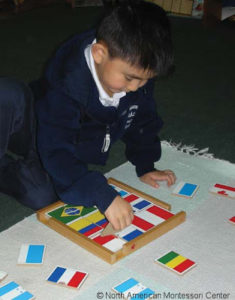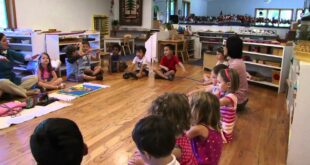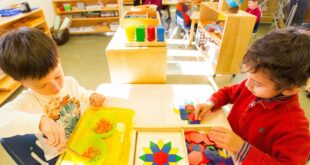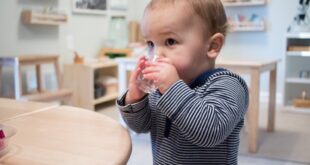 Maria Montessori herself said, “The greatest sign of success for a teacher… is to be able to say, ‘The children are now working as if I did not exist.’” You have prepared the environment with the child’s inner needs foremost in your mind. Now you’re probably thinking ahead to the day when your classroom will be normalized.
Maria Montessori herself said, “The greatest sign of success for a teacher… is to be able to say, ‘The children are now working as if I did not exist.’” You have prepared the environment with the child’s inner needs foremost in your mind. Now you’re probably thinking ahead to the day when your classroom will be normalized.
Normalization Begins With Practical Life
Normalization: When the children freely choose their work, concentrate, and are working blissfully on their own as members of a respectful, peaceful community.
As a Montessorian, you strive to provide an enriched, stimulating environment which fosters order, coordination, concentration, and independence – and environment within which the child is an active explorer and learner and can develop self-direction and a true love of learning. Your role is to nurture the growth of the child cognitively, socially, emotionally, and physically.
Learning care of self and care of the environment in the Practical Life area will assist the children as they venture to other parts of the classroom. The time you spend reinforcing Practical Life activities, including Grace and Courtesy, will pay off. The concentration level of the children will increase and normalization will take place. You’ll have a peaceful, orderly classroom for the length of the school year. Observing a child carefully rolling a mat, carrying a tray, and tucking in a chair never grows old.
At the beginning of the school year, focus on Grace and Courtesy.
These activities can help the child become oriented to the prepared environment and serve as tools for functioning in the classroom, using the materials, and interacting with others. Grace and Courtesy activities are important for establishing respect for self and others, an important aspect of the path to normalization.
Grace and Courtesy is a great way to get your older children involved in helping the younger. Dr. Montessori, in The Absorbent Mind reminds us that children of varying ages work well together: “Our schools show that children of different ages help one another. The younger one sees what the older ones are doing and asks for explanations. There is a communication and harmony between the two that one seldom finds between the adult and the small child.”
The older children act as role models when they are engaged in their own work and when they give Grace and Courtesy lessons to their new, younger friends. Some favorite back-to-school Grace and Courtesy activities are greeting, rolling a rug, tucking in a chair, and asking to observe or participate.
Prepare a strong Practical Life area.
The foundation for all other areas of the classroom, Practical Life helps the child build toward and prepare for work in other areas. The left to right pouring activities not only help the child increase concentration, coordination, order, and independence, they indirectly help the child prepare for reading from left to right. Practical Life activities teach care of self and care of the environment and help children function in the prepared environment.
Place the right amount of Practical Life activities on the shelves at the beginning of the school year. This is a thought-provoking process. Take time to examine your list of children and place materials that meet their developmental needs.
Start with the preliminaries. Having too many activities can be overwhelming for new children while not having enough inviting work for older children can be frustrating. As the year progresses, remember to rotate activities.
Add activities (and variations and extensions) as the year progresses. At the beginning of the year, appeal to the new children with a pairing work made of cute teddy bears or small cars. Sorting colorful wooden beads is another favorite.
Wait until later in the year to introduce a process development activity like Table Scrubbing. Put a sweeping activity in its place. The younger children will be able to complete the process. Older children can give lessons (boosting self-esteem and reinforcing knowledge) and help tidy the classroom.
Don’t get discouraged if the children are not normalizing as quickly as you expected. Remind yourself that laying the Montessori foundation takes time. Children adjust to new surroundings, new friends, and new routines at their own pace.
Use your observation skills. Notice which materials the children are drawn to and which materials the children avoid. Do you need to change a tray or pitcher to make the work more appealing? Will another lesson help? Are you inviting the child to the appropriate lessons?
Of course, the rest of the environment should be prepared with an equal amount of care. Making sure activities are complete, arranged beautifully on the shelves, and in the proper sequence will assist the child in his development.
Tips for helping parents understand normalization.
E. M. Standing, in his book Maria Montessori: Her Life and Work states: “The crowning characteristic of a group of normalized children is joy. It pervades the little community like a perfume; and is as hard to describe as it is easy to perceive.” Of course “seeing is believing” but verbally communicating to parents what takes place during normalization can be a challenge.
Simply put, during normalization, the child is becoming his best possible self and doing so without effort and with complete joy.
Dr. Montessori’s observations revealed that certain characteristics develop and are refined within the normalized child: love of work; concentration; self-discipline; and sociability.
The term “work” often takes parents aback. Explain it.
“My child doesn’t need to work. Work is what adults do.” E. M. Standing explains the child’s work as “any activity which involves the child’s whole personality, and has at its unconscious aim the construction of personality. It is definitely a form of self-expression, and brings the child a corresponding joy in the performance of it.”
Point out to parents that the child’s work is qualitatively different from the adult’s. The child works to develop self. The work is about the journey, not the product. When a child finishes a painting he’ll most likely take it to the drying rack and forget about it. It’s about the process not the product. After completing the Pink Tower, a young child will take it down and repeat many times, each time finding the work as thrilling as the time before. Adults work to change the environment. Children use the environment to change themselves.
Some Montessori schools call the activities on the shelve “jobs.” Whatever your terminology may be, let the parents know that the child’s aim is to develop self through purposeful activities.
Parents are amazed at the quiet they witness in a Montessori classroom full of happily working children.
Concentration is the key. When the children are concentrating, you can hear a pin drop. Their focus is so intense that they are unaware of what is going on around them. Remember Montessori’s story of physically moving a child so deeply concentrating on the knobbed cylinders that he continued the activity undisturbed. Equate the child’s experience to that of an adult reading a good book, so engrossed that three hours and the world around him disappear.
Take photos and videos of normalized children working in the classroom. Show them to parents when you’re explaining normalization. “A picture is worth a thousand words” is certainly true in this case. Also, explain to parents that the young child has an innate love of silence. Describe the silence game and the joy it brings.
Share Montessori’s observations. Use Dr. Montessori’s description of normalization from The Absorbent Mind when talking with parents: “An interesting piece of work, freely chosen, which has the virtue of inducing concentration rather than fatigue, adds to the child’s energies and mental capacities, and leads him to self-mastery.”
Simply put, the normalized child works without fatigue. When the work is completed, the child feels refreshed and joyful.
Establish a drop-off routine as early as possible.
This is a good first step in getting the children normalized. Routines reinforce the young child’s innate love of order. Not only does a child have an inner need for things to be kept in their place, he also has a need for routine.
Some parents find drop-off time more difficult than the children do. Having a set routine in place will help make the transition smooth for everyone and help the normalization process. Some Montessori teachers greet the children at the car, allowing parents to leave immediately. Other teachers greet children at the playground gate, allowing outside time before the day begins.
Whatever you choose, make sure parents drop off at the designated area and at the designated time. This will make for an easy transition into the classroom, leaving the child feeling safe and secure which will help with the normalization process.
Starting the day together, as a group, helps build a sense of community and helps the children feel secure. Arriving on time also reinforces being respectful, polite, and considerate of others. If a child arrives to the classroom late, it disrupts the other children and the teachers in the classroom, and it can also make it difficult for the late-arriving child to enter the classroom alone. Again, not disturbing a child’s sense of order will help with normalization.
Let parents know they can directly support normalization by:
- Driving the same route to school every day (“We’re getting close to your school… I see the tall walnut tree.”).
- Arriving on time in the morning. Parents who drop off late should not enter the classroom. Good byes should be said at the door, before the child enters the classroom.
- Saying good bye at the same place (“Let’s have our big hug at the gate!”).
- Picking the child up at the same time (“Mom will pick you up after you eat your lunch!”).
Tips for handling parent observations.
What takes place in the Montessori classroom is sometimes a mystery to parents. When a parent asks his child, “What did you do today?” the child usually responds with “I don’t know” or “Nothing.” A good way for parents to actually see their child in action and to understand normalization is to observe the child during the course of the school day.
At the beginning of the year, let parents know you will schedule days in the months ahead when they are welcome to observe. After the children become normalized, parents will get a true picture of the Montessori classroom.
In the perfect world, your school has an observation room. This is the best way for a parent to observe the child. The child cannot see the parent and will not alter his behavior.
If you don’t have an observation room, seating parents in the classroom is the next best thing (print out guidelines for observing to help parents understand the importance of being non-intrusive). In any case, schedule observation days for interested parents once the class has become normalized.
Today’s Montessori teachers might describe normalization as: every teacher’s wish for every child! Set your children on the path to Dr. Montessori’s ideal. Set the tone for the new school year by emphasizing Grace and Courtesy right away. Prepare the environment with what the children need to achieve her ideal. And, help parents understand normalization and their role in helping children develop into it. Before you know it, the child’s whole community will witness the beauty of the normalized child – utter joy!
 Montessori blog Montessori blog
Montessori blog Montessori blog 



https://ludeon.com/forums/index.php?topic=57260.0
https://ciprofloxacin.life/# buy cipro online
http://amoxil.icu/# amoxicillin for sale
prednisone 10mg buy online: buy cheap prednisone – prednisone canada pharmacy